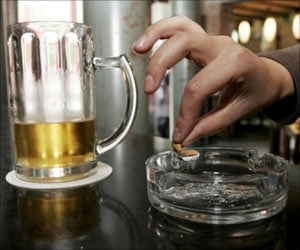Exposure to alcohol advertising changes teens' attitudes about alcohol, and can cause them to start drinking, reports a new study.

‘Teen alcohol use is a major public health problem, with negative consequences ranging from injuries, including those from car crashes, too risky sexual behavior, to damage to the developing brain.
’





Teen alcohol use is a major public health problem, with negative consequences ranging from injuries, including those from car crashes, too risky sexual behavior, to damage to the developing brain. Research shows that teen exposure to advertising is associated with drinking attitudes and behavior, but it has been unclear if these associations are causal.There is scientific consensus that advertising by the tobacco industry--which has had a long history of marketing directly to youth--causes teen smoking. The National Cancer Institute, Master Settlement Agreement, and Surgeon General's 2012 Report on Preventing Tobacco Use Among Youth and Young Adults all agree that the evidence is strong enough to say that there is a causal relationship; the Surgeon General used a four-level hierarchy system to classify the strength of causal inferences based on available evidence, as well as statistical estimation and hypothesis testing of association.
"The conclusion that the association between exposure to tobacco advertising and adolescent tobacco use are causally allowed for policy development that justified further regulation of tobacco advertising aimed at youth," said Michael Weitzman, MD, professor of pediatrics and environmental health at NYU Grossman School of Medicine and NYU School of Global Public Health. "The conclusion also set the framework to investigate a potentially analogous relationship with alcohol."
In this study, Weitzman and his coauthor Lily Lee of SUNY Downstate Medical Center used one of the key elements of the Bradford Hill criteria--a well-known framework for determining causal links between environmental exposures and disease--to determine whether marketing is a cause of youth alcohol use, focusing on the criterion that relies on analogous relationships already established as causal. The same criteria have been used to establish that smoking is a cause of cancer and that tobacco marketing is one cause of youth smoking. The researchers compared the same categories the Surgeon General used to deem a causal relationship between tobacco advertising and youth smoking--including marketing strategies, frequency and density of ads, and teens' attitudes toward and use of cigarettes--to the case of alcohol.
They found that in every aspect studied, the influence of tobacco and alcohol advertising on teens were analogous. For instance, both tobacco and alcohol companies have used mascots in advertisements (e.g., Joe Camel, the Budweiser frogs), which research shows are easily recognized and trusted by children. In addition, both tobacco and alcohol companies use or have used movies, television, and sporting events as opportunities for advertising and product placement, with studies showing that exposure to smoking and drinking increases the risk for youth initiation.
Advertisement
Finally, the researchers found that exposure to tobacco and alcohol advertising and teen knowledge, attitudes, initiation, and continued use of the products are extraordinarily similar. Many studies show that advertising is a risk factor for both smoking and drinking, with several studies showing a dose-dependent relationship, with more exposure to advertising increasing consumption.
Advertisement
"The association of alcohol and tobacco advertising exposure and adolescent perceptions, knowledge of, and use of these substances are remarkably similar, adding to the much-needed evidence that the association between alcohol advertising and teen alcohol use is causal in nature," concluded Weitzman.
Source-Eurekalert















